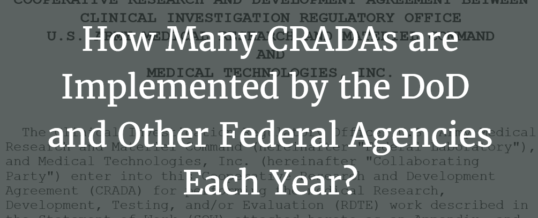MAR
The Department of Defense (DoD) and other military assisting Federal Agencies have a large and diverse community of subject matter experts (SME) who are eager to collaborate with industry and universities. These extraordinary SMEs are driven to accelerate new and novel dual-use technologies forward to clinical and operational settings. There are thousands of healthcare providers in 167 DoD medical treatment facilities within the U.S. (63 Air Force MTFs); tens of thousands of researchers in the ...
Continue Reading →OCT
There are many types of Cooperative R&D Agreement (CRADA) instruments and processes used by the Department of Defense (DoD), Department of Veterans Affairs (VA) and other Federal Agencies. Each type of CRADA presents a different mechanism or path to establishing meaningful and long-term collaborations between Federal and non-Federal entities to foster R&D innovation and improve the transition and commercialization of required technologies. This list of the types of CRADAs utilized by the DoD and VA is not ...
Continue Reading →JUN
Cooperative R&D agreements (CRADAs) and other DoD technology transfer mechanisms (e.g., licensing, patents, and publishing) help to convey knowledge, ownership rights, or establish formal research agreements between Federal and non-Federal entities. Of these instruments, CRADAs provide a convenient mechanism for these entities to collaborate, but how many CRADAs are completed by each Federal entity each year?
Asking questions like this is important for a company when considering if they should build a long-term business relationship with ...
Continue Reading →JUN




